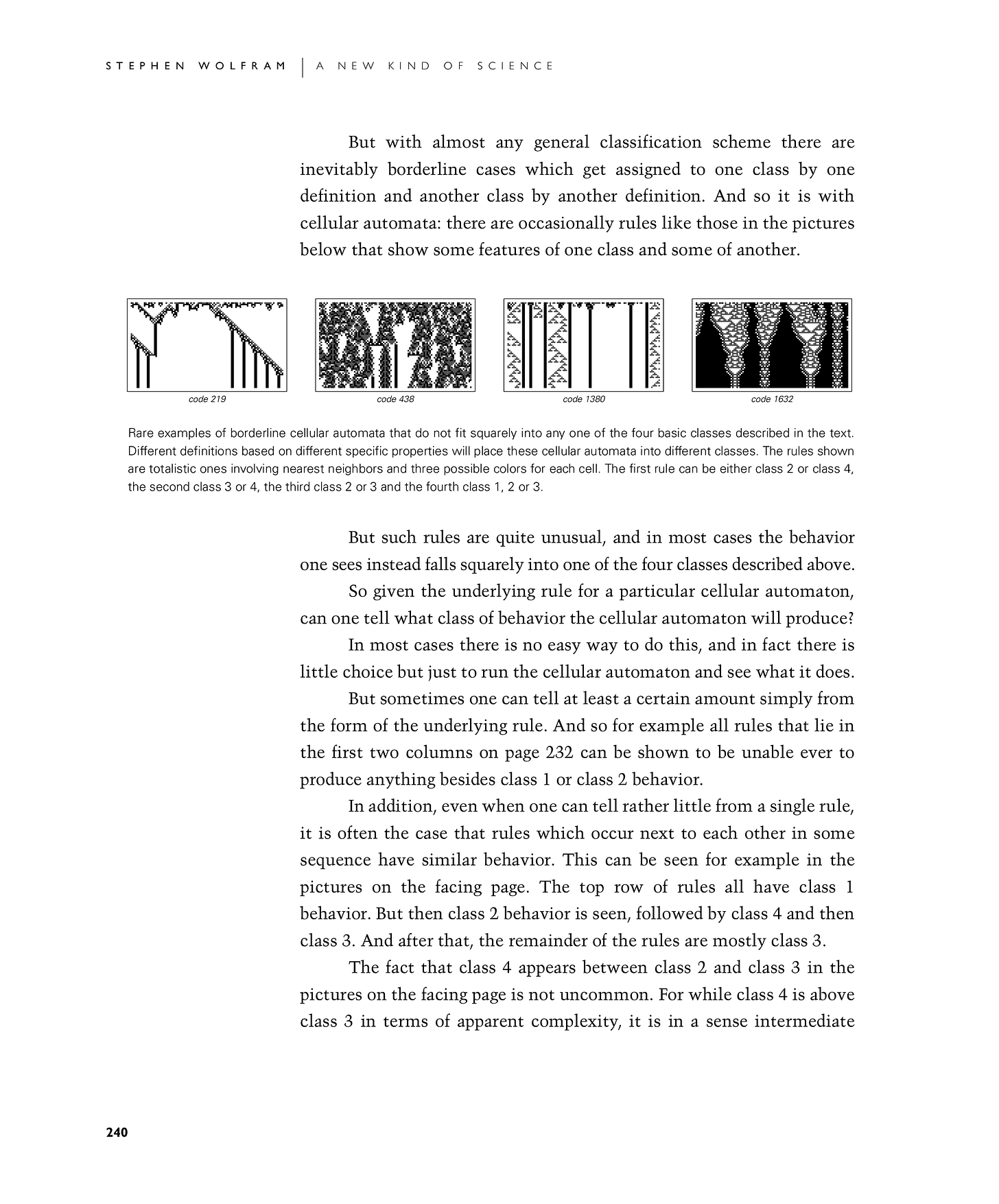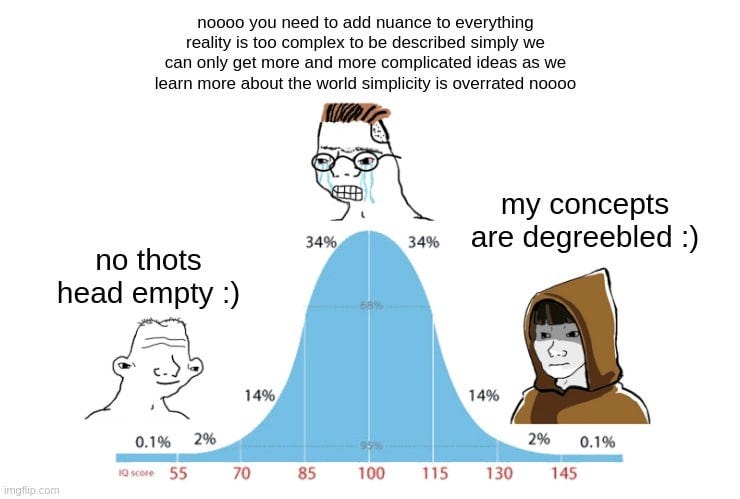Degreebling 1/4: Revisiting Greebling
4 types of greebling
Are you a greebler or degreebler?
Let me remind you what that is.
Definition - a kind of property of systems
Full elaboration of the concept can be found in @antlerboy's "Universe is greebling" article from April 2021. This was a big thing on Twitter back then. @pee_zombie contributed much to the discourse on the topic.
As you see @pee_zombie's thinking has that clean crisp formalism, and a new sheen of tpot-core abstractness. Checkout the whole thread tbf, it is good.
This post is part of a four essay series investigating degreebling. This one answers the question of what is the general trend of the Universe on this topic? The second will explore greebling of our world-models, not the world iteslf. Based on that, the third one will examine how our individual and social psyche is influenced by the greebledness prevailing world models. The last one will consider whether we should greeble, and if yes, how much.
I promised to tell you what is the general trend of the Universe on this topic. We can now rephrase that as 'does greebling have a telos?'.
Telos is the end of a process, already assuming a non-static graph. Before we talk about telos then we need to examine more local trends - we don't have direct access to the Ultimate Trends.
Possible models of greebling
Ok so we have instances of greebling. Are these a part of a monotonic world-greebleness metric increase? Maybe the world was greebled in its first 7 days, and since then its greebleness remains constant?
Then we have two descriptive questions about the process.
Is this ebbs-and-flows going 2 steps forward and 1 step back? or a monotonic graph? That is the same as whether greebling goes ceaselessly or there are stops or reversals?
The second one is the telos question - does this lead to anything?
We need to compare Universes here. A model would be useful, and what is the simplest Universe-model? One dimensional cellular automata.
There are 4 classes of these. Class 1 is a static end. All black or all white. The 'One-God Universe'. Class 2 is eternal recurrence. Not dull, but if you watch long enough, it's a circle. Class 3 is chaotic, with no discernible patterns ocurring over lower than permutational timescales. That is a maximum entropy universe. The last class, class 4 is a sea of randomness with islands or order.
Read more here.
We need to remember number 1 can appear only after a VERY LONG time, and it might often seem 3 and 4 are the case locally. In a certain sense, 1 is a subtype of 2.
How does this relate to degreebling? The metric we defined, Gr is perfectly applicable to those universes too. We have an outside view to these cellular universes. Theories about our universe say they have such a view about it, so we can classify them according to the same classification.
That will allow us to exhaustively assign any POV onto the 4 classes and make corresponding predictions.
Class 1 phenomena
We start our examination with the 'goes static' view. It is quite tempting psychologically. It gives the most certainty.
Borges' 'The Garden of Forking Paths' has a Chinese spy say the following
'the author of an atrocious undertaking ought to imagine that he has already accomplished it, ought to impose upon himself a future as irrevocable as the past'.
That view, that everything has been degreebled is dangerous in its certainty. It is represented in the Christian and Muslim view of "everything important has already been said, conclusion of the World is preordained, we're just waiting”. It is thoroughly degreebled.
Its final accumulation we find in no one other that Ye. Through saying the world-stage changing words 'everything is exactly the same', when asked about the difference between his approaches to music and fashion made him the ultimate degreebler.
Degreebling detail and richness of the world into a single concept. That is a totalitarian One God Universe, using CCRU terminology.
Degreebling is modernity. Scientific method is a degreebling-engine. Yes, logical positivists land in the same bucket as fundamentalist monotheists. Ladder of Being culminating in Man is like that. Its Christian predecessor too.
Class 1 is eschatonic, dealing with Universe Endgames. These can have already happened or are yet to come. Regardless, the process is underway and we all can see the end. All doomsday cults exploit this vulnerability.
That makes quite many things coded as grey tribe and enlightened belong there too! SSC's post on wireheading is a great example.
In regards to epistemic final-patterns, the Endgame is epistemic. It is a location that you'll achieve with enough knowledge. Ecclesiastes says there's only suffering and pain.
This final knowledge could be not knowing anything, like Socrates. Or gnosis:
a little knowledge leads away from God, but much knowledge leads towards Him
This quote, probably from Francis Bacon tells us the midwit meme, showing Knowledge-of-God as the location arrived at when increasing knowledge enough.
Class 2 phenomena
These are all about cycles. That is a large topic I will devote more words in future posts. For now I'll just mention the theories. There is a multitude of those, across genres and text types, from Nietzsche's eternal return to Mass Effect Reapers and galactic life.
A spiral is a kind of such a trend. @pee_zombie described spirals of thought: this is a natural cycle; we start off with way-too-simple conceptions of reality, iteratively greeble them to capture nuances we discover in our search for truth, and then, ideally, discover underlying symmetries and degreeble them to recover that beatific state of head empty
These spirals aim at class 1 'head empty' i.e. ataraxia state. That is personal though, not Universe level.
It can arrive in other dynamic 'locations' too. For instance Hegelian thought is a spiral, but not towards nothing, but towards the Absolute.
After Hegel we must discuss Marx, who in obvious ways uses the spiral of crises in each of the systems and the phase changes between them, with another culmination present. In a certain sense, Communism in his system is another kind of endgame like Class 1. Same for Landian analysis. Paperclips would do that too.
But for some theorists, capitalism need not end. Spirals do not need to end.
Other spirals that might not have an end are commonplace. These include Kuhnian science and the trend of life's increasing ecological complexity (as number of species) over the fossil record. Note the similarity of taxonomic tree to epistemic tree!
We have clear local losses of complexity through mass extinctions, but that is only local texture, not the overall trend.
Class 3 phenomena
4 months after the optimistic degreebler tweet, @pee_zombie posted this. > fucked up how the more i learn, the less i know each new bit of knowledge contains some novelty I hadn't previously considered, a degree of freedom I wasn't aware existed. a new dimension along which information can lie the space of possible knowledge grows exponentially It seems the original notion was not a real addition of complexity, but an illusion of it. Knowledge didn't increase either.
In a truly chaotic world, that would be the pattern. Class 3 is rare in humans. To see the world as truly chaotic is alien to the human psyche. Depressed POV and Lovecraftian cosmicism share this view, but that is rarely developed into an actionable lifestyle.
Class 4 phenomena
That's where things get the most interesting. These Universes are where all adventure stories take place.
@antlerboy’s first article says ‘the Universe if greebling’ as if greebling is a one directional monotonic trend, increasing in time.
@antlerboy's subsequent post states explicitly that the pattern of knowledge is neither linear nor spiral. Some bits wax, some wane. @pee_zombie's tweets were a subsequent development and postulated degreebling, creating the spiral.
Going further back into history, from 2021 to the 80s, we see that Deleuzian mindset goes here, using planes of immanence (local optima) as a base camp from which to discover new forms of being through deterritorialization.
Going even further back, the early 1910s give us the POV of dialectical materialism. This quote from Lenin warns against boiling our universe down to a complete model.
Human knowledge is not (or does not follow) a straight line, but a curve, which endlessly approximates a series of circles, a spiral. Any fragment, segment, section of this curve can be transformed (transformed one-sidedly) into an independent, complete, straight line, which then (if one does not see the wood for the trees) leads into the quagmire, into clerical obscurantism (where it is anchored by the class interests of the ruling classes).
Lenin, Summary of Dialectics (1914)
The warning is pragmatic and theoretical. It says the straightening is theoretically incorrect. But what if we make it complete, by stretching in many dimensions? That is what modern theoretics of Universe Endgames (e.g. Scott Alexander) do. Even if it is correct, Lenin warns us of the pragmatic consequences: we can expect clerical SSC obscurantism to emerge. The rumour among the Postrats is it already did...
Conclusion
We can see that the most sophisticated and world-embracing thinkers choose class 4, and class 1 thinking is a source of many failures.
Yet at the same time, the finite universe necessarily has an ending. The tech tree has an ending. Now that doesn't mean we reach it. Maybe we get stuck below the theoretical tech cap by repeatedly extincting ourselves. Or maybe we just end up as Scott Alexander's Wirehead Gods on Lotus Thrones...
OR
We might see the greebling-degreebling binary as a feature of the Universe, ineffability that we approximate with our language and mathematical models, and refuse to take a stance.
We have yet to see how this relates to our lives. The choice between being a greebler and a degreebler is unsolved...
There is 1 thing you can do to get closer to see this tension resolved…
One lifehack is evident even now, though. We can now assign patterns and models of our multi-dimensional world to the simplicity of the 4 classes of cellular automata. When seeing a problem, we can then assign it to one of the 4 classes (like an embedding) and in that small 2d space find an alternative, a way to look differently at it.





